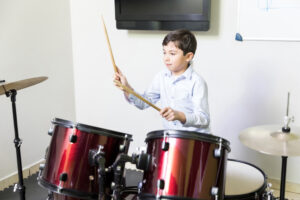If you’ve ever wondered whether your child is too young or too rowdy to start learning drums, you’re not alone. As drum instructors who teach private lessons to young beginners, we hear these concerns every week. Here’s why those ideas—what we call kids drum lessons myths—don’t hold up under scrutiny.
Myth 1: There’s a “Right” Age to Begin Drumming
Many people believe that kids must wait until age nine to start lessons—but that isn’t the whole story. While ages 9–12 do offer developmental advantages like focus and motor coordination, children under that age can also thrive—especially with a fun, age‑appropriate teacher.
If your child already shows interest—pounding on rhythm toys, tapping to songs—go ahead and give it a try. You can support readiness at home with simple rhythm games, hand percussion, or touchscreen drumming apps to build coordination early on.
Myth 2: Kids Under Seven Can’t Learn Drums
It’s easy to assume younger children won’t keep up—but many drumming prodigies begin even earlier. With the right setup, such as practice pads or junior-sized instruments, kids under seven can start learning basic beat patterns and coordination habits.
If you’re thinking about a starter kit or setup guidance, our blog post about how to set up a drum kit can help you select gear that fits your young drummer.
Myth 3: Teachers Won’t Connect with Young Students
Some argue drum instructors can’t keep the attention of kids under nine. But the truth is often the opposite: the best teachers make learning feel like playing. They use color-coded notation systems, games, and call-and-response techniques to make lessons lively and engaging.
The key is finding an instructor who understands children—not just the instrument.
Important Safety Notes for Young Drummers
Learning to drum comes with a few things to watch:
- Protect hearing: Drums can reach high decibel levels. We recommend ear protection like padded plugs or practice headphones. The American Speech-Language-Hearing Association offers guidelines on safe listening levels for kids.
- Use age-appropriate equipment: Start with a snare pad or compact kit with soft sticks.
- Focus on coordination—not force: Technique is more about rhythm accuracy than hitting harder.
Why the Myths Persist—and Why They Don’t Explain Everything
Yes, drums create sound. Yes, they consume space and need supervision. But the musical depth that lies beneath percussion—in rhythm, syncopation, timing, even theory—is rich and expressive. A good teacher will bring all of that to life—even for a 6-year-old just getting started.
FAQ: Setting Up Young Kids for Drum Lesson Success
My child isn’t strong—can they still learn drums?
Absolutely. Good drumming relies on coordination and rhythm—not muscle strength. Many children as young as 5 or 6 learn fine control through proper technique.
Is a drum kit too expensive to start?
Not necessarily. A basic kit or pad set can cost around $300, and you can always begin with just a kick, snare, and hi‑hat before expanding.
Won’t practicing drums be noisy or distracting?
There are many quiet alternatives—like practice pads and electronic kits with headphones—that make noise manageable in a home setting.
